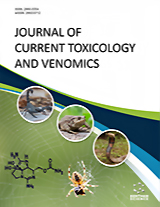Abstract
Introduction: Spiders are predators that use their venom to immobilize their prey. These spider toxins are able to affect the central nervous system of mammals.
Methods: We hypothesized that venom from the tarantula Vitalius platyomma may induce behavioral changes in male Wistar rats. To test this hypothesis, the behavioral effects of venom were investigated after intracerebroventricular microinjection using the neuroethological method (behavioral sequences) associated with the ETHOMATIC program, evaluating frequency, duration, and strength of statistical association between pairs (dyads) of behaviors.
Results: The results obtained in this present study showed that the intracerebral administration of V. platyomma crude venom provoked a difference in the time of freezing of animals. In addition, animals showed after the freezing period changes in the exploratory and grooming clusters and additional complex sequences of behaviors such as wild running.
Conclusion: This study clearly demonstrated the appearance of seizure-like behaviors, similar to audiogenic brainstem-dependent seizures such as those observed in genetically-selected audiogenic strains.
[http://dx.doi.org/10.1016/0166-2236(88)90112-9] [PMID: 2465627]
[http://dx.doi.org/10.1002/(SICI)1520-6327(1998)38:1<19:AID-ARCH3>3.0.CO;2-Q] [PMID: 9589602]
[http://dx.doi.org/10.1007/978-1-4939-9845-6_1]
[http://dx.doi.org/10.1073/pnas.92.1.1] [PMID: 7816795]
[http://dx.doi.org/10.1023/A:1011988317683] [PMID: 9487543]
[http://dx.doi.org/10.1016/S0041-0101(01)00199-4] [PMID: 11711120]
[http://dx.doi.org/10.1002/rcm.3223] [PMID: 17918214]
[http://dx.doi.org/10.1016/j.toxicon.2006.11.027] [PMID: 17223149]
[http://dx.doi.org/10.1016/B978-0-444-53490-3.00028-5] [PMID: 23829924]
[http://dx.doi.org/10.1016/j.neuropharm.2017.09.025] [PMID: 28941737]
[http://dx.doi.org/10.1016/S0065-2806(08)60086-7]
[http://dx.doi.org/10.1007/s11030-006-9050-4] [PMID: 17096075]
[http://dx.doi.org/10.3390/toxins7083179] [PMID: 26295258]
[http://dx.doi.org/10.3389/fphar.2018.00145] [PMID: 29527170]
[http://dx.doi.org/10.1016/0896-6273(88)90162-6] [PMID: 2908446]
[http://dx.doi.org/10.1038/sj.mp.4001551] [PMID: 15278097]
[http://dx.doi.org/10.3390/biom5043112] [PMID: 26569330]
[http://dx.doi.org/10.1007/s00018-018-2837-5] [PMID: 29766217]
[http://dx.doi.org/10.1016/j.ympev.2019.106573] [PMID: 31374259]
[http://dx.doi.org/10.1016/0006-8993(92)90515-B] [PMID: 1319261]
[http://dx.doi.org/10.1007/s00441-008-0738-x] [PMID: 19132396]
[http://dx.doi.org/10.1016/j.toxicon.2008.10.026] [PMID: 19032960]
[http://dx.doi.org/10.1016/j.toxicon.2013.04.020] [PMID: 23668938]
[http://dx.doi.org/10.1186/1678-9199-20-2] [PMID: 24495716]
[http://dx.doi.org/10.1016/j.bbrep.2015.09.018] [PMID: 29124220]
[http://dx.doi.org/10.1016/S0361-9230(00)00300-2] [PMID: 10974500]
[http://dx.doi.org/10.1016/S0361-9230(01)00495-6] [PMID: 11427341]
[http://dx.doi.org/10.1016/S0166-4328(05)80320-1] [PMID: 1335263]
[http://dx.doi.org/10.1016/S0166-4328(05)80321-3] [PMID: 1335262]
[http://dx.doi.org/10.1016/S0378-5955(02)00371-4] [PMID: 12117522]
[http://dx.doi.org/10.1016/j.yebeh.2017.04.001] [PMID: 28506440]
[http://dx.doi.org/10.1016/0166-4328(94)90035-3] [PMID: 7917031]
[PMID: 6686072]
[http://dx.doi.org/10.1016/S0166-4328(05)80138-X] [PMID: 1622553]
[http://dx.doi.org/10.1016/j.yebeh.2013.05.028] [PMID: 23872084]
[http://dx.doi.org/10.1016/j.yebeh.2015.11.005] [PMID: 26876275]
[http://dx.doi.org/10.1016/0003-2697(72)90094-2] [PMID: 4115981]
[http://dx.doi.org/10.1016/S0920-1211(96)00050-2] [PMID: 8985699]
[http://dx.doi.org/10.1159/000367885] [PMID: 25341457]
[http://dx.doi.org/10.1016/j.yebeh.2005.08.010] [PMID: 16246630]
[http://dx.doi.org/10.1016/j.yebeh.2009.12.030] [PMID: 20153261]
[http://dx.doi.org/10.1016/j.yebeh.2012.09.029] [PMID: 23146364]
[http://dx.doi.org/10.1016/0014-4886(84)90087-6] [PMID: 6437856]
[http://dx.doi.org/10.1016/0091-3057(91)90147-T] [PMID: 1784596]
[http://dx.doi.org/10.1016/0091-3057(92)90219-6] [PMID: 1594640]
[http://dx.doi.org/10.1016/0006-8993(95)00970-X] [PMID: 8925273]
[http://dx.doi.org/10.1016/0041-0101(93)90287-S] [PMID: 8456448]
[http://dx.doi.org/10.1034/j.1600-0773.2000.d01-28.x] [PMID: 10815747]
[http://dx.doi.org/10.1016/S0306-4522(03)00191-X] [PMID: 12770566]
[http://dx.doi.org/10.1016/S0920-1211(00)00107-8] [PMID: 10771251]
[http://dx.doi.org/10.1016/0006-2952(81)90510-4] [PMID: 6119088]
[http://dx.doi.org/10.1016/0166-4328(81)90038-3] [PMID: 7225219]
[http://dx.doi.org/10.1016/0031-9384(87)90231-9] [PMID: 3575473]
[http://dx.doi.org/10.1016/0031-9384(90)90127-P] [PMID: 2359770]
[http://dx.doi.org/10.1016/S0091-3057(98)00197-X] [PMID: 10080233]
[http://dx.doi.org/10.1007/s002130100697] [PMID: 11401004]
[http://dx.doi.org/10.3390/biomedicines10112934] [PMID: 36428502]
[http://dx.doi.org/10.1016/j.yebeh.2011.06.033] [PMID: 21820967]
[http://dx.doi.org/10.1016/j.yebeh.2012.04.133] [PMID: 22704998]
[http://dx.doi.org/10.1016/0006-8993(90)91243-A] [PMID: 2257489]
[http://dx.doi.org/10.1016/0006-8993(95)01334-2] [PMID: 8720508]
[PMID: 19333868]
[http://dx.doi.org/10.1007/BF02246415] [PMID: 8853221]
[http://dx.doi.org/10.1111/psyp.12465] [PMID: 26877127]









